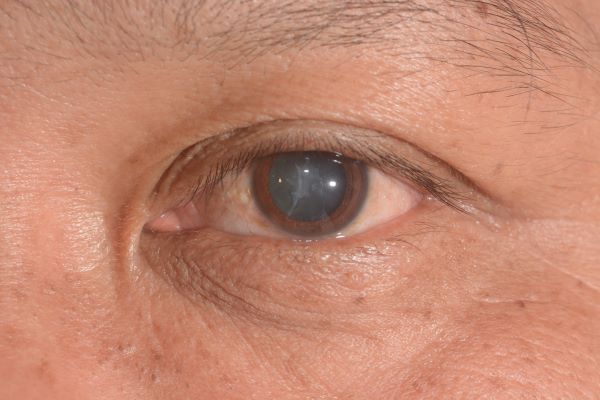Cataract Surgery Can Induce Dry Eye Disease (DED)
Cataract and cataract surgery
Cataract is a condition in which the natural lens in the eye loses its inherent transparency, restricting light from passing through the eye and thereby causing vision loss. In the early stages of the disease, a person may notice slight cloudiness because only a small part of the lens is affected. At this stage, treatment with spectacles is usually recommended to correct the blurry vision. When cataracts develop and severely affect vision, surgery is essential to remove the cloudy lens and replace it with an intraocular lens (IOL) to restore vision.1

There are three main types of cataract surgery. Depending on the eye’s condition, the center’s facilities and patient’s resources, one of the three is recommended:
- Manual small-incision cataract surgery (MSICS or SICS) can be performed in almost all types of cataracts.2
- Phacoemulsification cataract surgery (PCS) is the most popular surgical method today which uses high-frequency ultrasound waves to crush the cloudy lens.3
- Femtosecond laser-assisted cataract surgery (FLACS) is basically similar to PCS with the advantages of laser beams for incision and automation of some of the surgical steps.4
Cataract surgery and dry eye disease (DED)
Cataract surgery is capable of triggering dry eye symptoms due to ocular damage and tear film instability after the operation. The severity of dry eye peaks at day 1 postoperatively and continues for at least 1–12 months following the surgery.5
Besides, pre-existing DED is common among cataract patients, with 50-75% affected as both conditions increase with age.6 Underlying DED if not being well-addressed before cataract surgery can result in adverse outcomes such as fluctuating vision, refractive misses, worsened DED symptoms, and postoperative infections.7

Factors that lead to and worsen dry eye symptoms after cataract surgery include:
DED treatment before and after cataract surgery
For those who have had DED before the surgery, it is necessary to optimize treatment approach which include over-the-counter artificial tears as well as prescription eye drops. Patients with other eye diseases such as meibomian gland dysfunction may benefit from pre-operative care, including warm compressors, lid hygiene and treatment of demodex.16 In addition, treating dry eye both before and after surgery with lubricating eye drops including gels and ointments is believed to help relieve dry eye symptoms, improve vision, and improve overall satisfaction of cataract surgery patients.17 Patients with severe DED can consider implanting punctal plug, a device inserted into the tear duct to stop tear drainage, maintaining the eye’s stability.18
For those who are suffering dry eye symptoms after cataract surgery, along with other treatments mentioned above, following measures may be considered:

- Sodeman, W.A. and Sodeman, T.C. "Cataracts: Patient and Caregiver's Guide". Instructions for Geriatric Patients (3rd edition). W.B. Saunders. 2005.
- Jha, K.N. and Vats, D.P. Manual Small Incision Cataract Surgery: Experience at a Military Hospital. Medical Journal Armed Forces India 2006;62(3):212-215.
- Linebarger, E.J., et al. Phacoemulsification and Modern Cataract Surgery. Survey of Ophthalmology. 1999;44(2):123-147.
- Roberts, H.W., et al. A randomized controlled trial comparing femtosecond laser– assisted cataract surgery versus conventional phacoemulsification surgery. Journal of Cataract and Refractive Surgery 2019;45(1):11-20.
- Miura, M., et al. Prevalence and Characteristics of Dry Eye Disease After Cataract Surgery: A Systematic Review and Meta-Analysis. Ophthalmology and Therapy 2022;11(4):1309-1332.
- Don't Let Dry Eye Derail Cataract Surgery. American Academy of Ophthalmology. https://www.aao.org/eye-health/tips-prevention/dry-eye-cataract-surgery-ocularsurface-disease (Accessed 2023-04-06).
- Starr, C.E., et al. An algorithm for the preoperative diagnosis and treatment of ocular surface disorders. Journal of Cataract and Refractive Surgery 2019;45(5):669-684.
- Kim, J.H., et al. Change in Corneal Sensitivity and Corneal Nerve after Cataract Surgery. Cornea 2009;28(11):S20-S25.
- Rosenthal, P., et al. Oculofacial Pain: Corneal Nerve Damage Leading to Pain Beyond the Eye. Investigative Opthalmology & Visual Science 2016;57(13): 5285-5287.
- Hwang, H.B. and Kim H.S. Phototoxic Effects of an Operating Microscope on the Ocular Surface and Tear Film. Cornea 2014;33(1):82-90.
- Kato, K., et al. Management of Postoperative Inflammation and Dry Eye After Cataract Surgery. Cornea 2019;38(1):S25-S33.
- Li, X.-M., et al. Investigation of Dry Eye Disease and Analysis of the Pathogenic Factors in Patients after Cataract Surgery. Cornea 2007;26(Suppl. 1):S16-S20.
- Yu, Y., et al. Evaluation of dry eye after femtosecond laser–assisted cataract surgery. Journal of Cataract and Refractive Surgery 2015;41(12):2614-2623.
- Chen, W.-T., et al. Dry Eye Following Femtosecond Laser-Assisted Cataract Surgery: A Meta-Analysis. Journal of Clinical Medicine 2022;11(21):6228.
- Ishrat, S., et al. Incidence and pattern of dry eye after cataract surgery. Saudi Journal of Ophthalmology 2019;33(1):34-40.
- Song, P., et al. Preoperative Management of MGD Alleviates the Aggravation of MGD and Dry Eye Induced by Cataract Surgery: A Prospective, Randomized Clinical Trial. BioMed Research International 2019;2019:1-10.
- Ganesh, S., et al. Topical Cyclosporine (0.05%) for Management of Dry Eyes in Patients Undergoing Cataract Surgery-A Comparative Study. The Open Ophthalmology Journal 2019;13(1):34-42.
- Gayton, J. Etiology, prevalence, and treatment of dry eye disease. Clinical Ophthalmology 2009;3:405-412.
- Jee, D., et al. Comparison of treatment with preservative-free versus preserved sodium hyaluronate 0.1% and fluorometholone 0.1% eyedrops after cataract surgery in patients with preexisting dry-eye syndrome. Journal of Cataract and Refractive Surgery 2015;41(4):756-763.
- Alio, J.L., et al. Treatment of Dry Eye Disease with Autologous Platelet-Rich Plasma: A Prospective, Interventional, Non-Randomized Study. Ophthalmology and Therapy 2017;6(2): 285-293.
- Wu, X., et al. Efficacy of bandage contact lens for the management of dry eye disease after cataract surgery. International Ophthalmology 2021;41(4):1403-1413.
Five‐item Dry Eye Questionnaire (DEQ-5).
관련 게시물
Five‐item Dry Eye Questionnaire (DEQ-5).
Five‐item Dry Eye Questionnaire (DEQ-5).









